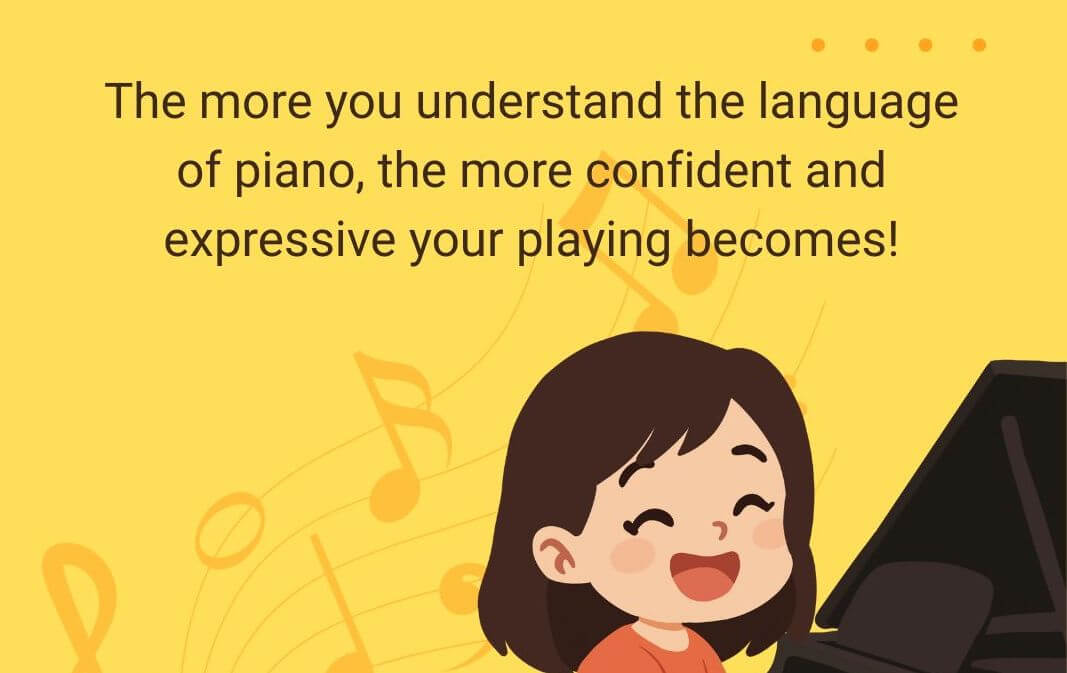Blog
Vocab Every Piano Player Needs to Know

Whether you’re just starting out or you’ve been playing for years, understanding key terminology can dramatically improve your experience at the keys. From sheet music to technique, mastering the vocab every piano player needs to know will give you more confidence, clarity, and creativity in your practice and performance.
In this article, we’ll explore the foundational vocabulary that every pianist should understand—and why it matters.
Why Piano Vocabulary Matters
Music is a language, and like any language, it has its own set of terms. The vocab every piano player needs to know serves as the bridge between written music, technical instruction, and expressive artistry. Without it, even simple instructions can feel like a mystery.
Having a strong vocabulary:
- Makes learning new pieces easier
- Helps you communicate effectively with teachers and fellow musicians
- Enhances your ability to interpret and express musical ideas
Essential Notation Terms
Knowing how to read sheet music is a fundamental skill, and it starts with understanding these basic terms:
- Staff – The five lines where notes are written.
- Clef – Tells you which notes are where (e.g., Treble Clef for right hand, Bass Clef for left).
- Measure – A segment of time defined by a set number of beats.
- Time Signature – Indicates how many beats per measure and what note value counts as one beat.
- Key Signature – Shows which sharps or flats are used throughout a piece.
These terms form the core of the vocab every piano player needs to know if you want to read music fluently.
Tempo Terms Every Pianist Should Know
Tempo refers to the speed of the music. These terms are some of the most common you’ll encounter:
- Allegro – Fast and lively
- Andante – At a walking pace
- Largo / Lento – Very slow and broad
- Moderato – At a moderate tempo
- Accelerando – Gradually getting faster
- Ritardando – Gradually slowing down
- Rubato – Flexible tempo for expressive timing
These tempo terms are a vital part of the vocab every piano player needs to know to play expressively and with intention.
Dynamics and Expression
Music isn’t just about playing the right notes—it’s about how you play them. Dynamics indicate how loud or soft to play.
- Pianissimo (pp) – Very soft
- Piano (p) – Soft
- Mezzo piano (mp) – Moderately soft
- Mezzo forte (mf) – Moderately loud
- Forte (f) – Loud
- Crescendo – Gradually get louder
- Decrescendo – Gradually get softer
Understanding these dynamic terms helps transform your playing from mechanical to musical, and they’re a crucial part of the vocab every piano player needs to know.
Articulations That Shape Your Sound
Articulations indicate how individual notes should be played. They’re small symbols with a big impact.
- Legato – Play smoothly and connected
- Staccato – Play short and detached
- Tenuto – Hold the note for its full value with slight emphasis
- Accent – Emphasize the note
- Slur – Play a group of notes smoothly without separation
Knowing these articulation marks helps bring phrasing and character to your music—key parts of the vocab every piano player needs to know.
Technique Terms for Stronger Playing
To play piano efficiently and beautifully, you need to understand the technical language used in instruction:
- Fingering – Numbered notation for which fingers to use.
- Hand Position – How your hands should be placed over the keys.
- Scales – A sequence of notes in a particular key, ascending and descending.
- Arpeggios – Playing the notes of a chord one at a time.
- Pedal Markings – Instructions for when to use the sustain (damper) or soft (una corda) pedal.
These technique-related terms are essential in the vocab every piano player needs to know to build muscle memory and speed.
Chord and Harmony Basics
Harmony adds richness to music. Here’s some foundational vocab:
- Chord – A group of notes played together.
- Triad – A three-note chord (root, third, fifth).
- Major/Minor – Describes the quality of a chord or key.
- Inversion – When the chord’s notes are rearranged in a different order.
- Cadence – A sequence of chords that ends a phrase or piece.
If you’re diving into songwriting or improvisation, this section of the vocab every piano player needs to know is especially important.
Final Thoughts: Make These Words Part of Your Practice
The more you incorporate the vocab every piano player needs to know into your daily routine, the more fluent you’ll become in the language of music. Try keeping a glossary notebook, labeling new terms in your sheet music, or reviewing vocabulary weekly.
When you speak the language of music fluently, your playing becomes more expressive, efficient, and enjoyable—because you’re not just pressing keys; you’re telling a story.

